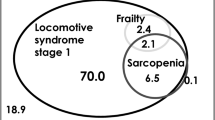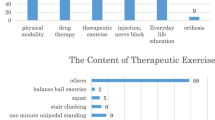Abstract
Introduction
Locomotive syndrome (LOCOMO) is defined by the Japanese Orthopaedic Association (JOA) as a condition requiring nursing care due to a decline in mobility resulting from musculoskeletal disorders. In 2020, the JOA announced the new definition of LOCOMO stage 3 and revision of clinical decision limits in stages of LOCOMO. However, there are few reports on the epidemiological indices of LOCOMO. This prospective cohort study aimed to investigate the prevalence, incidence, and association of poor prognosis with LOCOMO stages.
Materials and methods
The third survey of the Research on Osteoarthritis/Osteoporosis Against Disability (ROAD) study was conducted during 2012–2013, examining a population-based cohort of 1575 participants (513 men and 1062 women, mean age 65.6 years). Three LOCOMO risk tests were performed, and patients were classified into LOCOMO stages 0, 1, 2, and 3. They were followed up for 6 years, and identical examination of LOCOMO was performed in 3- and 6-year follow-ups. Data on patients’ prognoses, including disability and death, were collected.
Results
The prevalence of LOCOMO stages 1, 2, and 3 was 41.3, 14.9, and 11.6%, respectively. The incidence of LOCOMO stages 1, 2, and 3 were 83.7, 23.0, and 18.6 per 1000 person-years, respectively. Compared with LOCOMO stage 0, logistic regression analysis showed that LOCOMO stage 3 significantly increased the risk of disability and mortality. In addition, each value of LOCOMO risk tests for LOCOMO stage 3 increased the risk of poor prognosis.
Conclusion
LOCOMO stage 3 is a sensitive indicator of future disability and mortality.




Similar content being viewed by others
Data availability
Not applicable.
Code availability
Not applicable.
Change history
14 June 2022
A Correction to this paper has been published: https://doi.org/10.1007/s00774-022-01349-z
References
Ministry of Health, Labour and Welfare The outline of the results of National Livelihood survey (2019). https://www.mhlw.go.jp/toukei/saikin/hw/k-tyosa/k-tyosa19/ (in Japanese) Accessed 25 Mar 2022
Nakamura KA (2008) A ‘super-aged’ society and the ‘locomotive syndrome.’ J Orthop Sci 13:1–2. https://doi.org/10.1007/s00776-007-1202-6
LOCOMO online, Japan orthopaedic association locomotive syndrome prevention awareness official website (in Japanese). https://locomo-joa.jp/check/test/ Accessed on 22nd Feb 2022
Locomotive syndrome. Locomotive syndrome pamphlet 2013 (2013). https://www.med.or.jp/dl-med/doctor/ssi/sports25/sports25_k14.pdf. In: locomotive challenge council. Japanese orthopaedic association, Tokyo. Accessed on 22 Feb 2022
Locomotive syndrome. Locomotive syndrome pamphlet (2015) (in Japanese) (2022). In: htmlLocomotive challenge council. https://locomo-joa.jp/news/upload_images/locomo_pf2015.pdf. Japanese orthopaedic association, Tokyo. Accessed 22 Feb 2022
Yoshimura N, Muraki S, Oka H, Mabuchi A, En-Yo Y, Yoshida M, Saika A, Yoshida H, Suzuki T, Yamamoto S, Ishibashi H, Kawaguchi H, Nakamura K, Akune T (2009) Prevalence of knee osteoarthritis, lumbar spondylosis, and osteoporosis in Japanese men and women: the research on osteoarthritis/osteoporosis against disability study. J Bone Miner Metab 27:620–628. https://doi.org/10.1007/s00774-009-0080-8
Yoshimura N, Muraki S, Oka H, Kawaguchi H, Nakamura K, Akune T (2010) Cohort profile: research on osteoarthritis/osteoporosis against disability (ROAD) study. Int J Epidemiol 39:988–995. https://doi.org/10.1093/ije/dyp276
Yoshimura N, Muraki S, Nakamura K, Tanaka S (2017) Epidemiology of the locomotive syndrome: the research on osteoarthritis/osteoporosis against disability study 2005–2015. Mod Rheumatol 27:1–7. https://doi.org/10.1080/14397595.2016.1226471
Locomotive syndrome (in Japanese) (2020). In: Japanese orthopaedic association (ed.), Tokyo. Locomotive syndrome pamphlet 2020. https://locomo-joa.jp/assets/pdf/index_japanese.pdf. Locomotive Challenge Council. Accessed on 22 Feb 2022
Seichi A, Hoshino Y, Doi T, Akai M, Tobimatsu Y, Iwaya T (2012) Development of a screening tool for risk of locomotive syndrome in the elderly: The 25-question geriatric locomotive function scale. J Orthop Sci 17:163–172. https://doi.org/10.1007/s00776-011-0193-5
Yoshimura N, Muraki S, Oka H, Morita M, Yamada H, Tanaka S, Kawaguchi H, Nakamura K, Akune T (2013) Profiles of vitamin D insufficiency and deficiency in Japanese men and women: association with biological, environmental, and nutritional factors and coexisting disorders: the ROAD study. Osteoporos Int 24:2775–2787. https://doi.org/10.1007/s00198-013-2372-z
Portal site of Official Statistics of Japan (2015). https://www.e-stat.go.jp/en/stat-search/files?page=1&toukei=00200521&tstat=000001080615&cycle=0&cycle_facet=cycle. Popul Census Accessed on 22 Feb 2022
What is the second stage of healthy Japan. https://www.kenkounippon21.gr.jp/kenkounippon21/about/index.html, vol 21? (in Japanese) Accessed on 22nd Feb 2022
Locomotive syndrome awareness survey report (in Japanese) (2022) https://www.bjd-jp.org/wp/wp-content/uploads/2020/05/2020.pdf Accessed 22 Feb 2022
Akune T, Muraki S, Oka H, Tanaka S, Kawaguchi H, Tokimura F, Yoshida H, Suzuki T, Nakamura K, Yoshimura N (2014) Incidence of certified need of care in the long-term care insurance system and its risk factors in the elderly of Japanese population-based cohorts: the ROAD study. Geriatr Gerontol Int 14:695–701. https://doi.org/10.1111/ggi.12155
Akune T, Muraki S, Oka H, Tanaka S, Kawaguchi H, Tokimura F, Yoshida H, Suzuki T, Nakamura K, Yoshimura N (2014) Association of physical activities of daily living with the incidence of certified need of care in the long-term care insurance system of Japan: the ROAD study. J Orthop Sci 19:489–496. https://doi.org/10.1007/s00776-014-0537-z
Yoshimura N, Muraki S, Oka H, Kawaguchi H, Nakamura K, Tanaka S, Akune T (2012) Does mild cognitive impairment affect the occurrence of radiographic knee osteoarthritis? a 3-year follow-up in the ROAD study. BMJ Open 2:e001520. https://doi.org/10.1136/bmjopen-2012-001520
Yoshimura N, Muraki S, Oka H, Tanaka S, Kawaguchi H, Nakamura K, Akune T (2015) Mutual associations among musculoskeletal diseases and metabolic syndrome components: a 3-year follow-up of the ROAD study. Mod Rheumatol 25:438–448. https://doi.org/10.3109/14397595.2014.972607
Portal site of official statistics of Japan. 2012 report of the national health and nutrition survey conducted by the ministry of health labour and welfare Japan. (in Japanese). https://www.e-stat.go.jp/stat-search/files?page=1&layout=datalist&toukei=00450171&kikan=00450&tstat=000001041744&cycle=7&year=20120&month=0&tclass1=000001064370&survey=健康&tclass2val=0 Accessed on 22nd Feb 2022
Acknowledgements
The authors wish to thank Dr. Naoki Hirabayashi of Kawakami Clinic, Hidakagawa Town; Mrs. Tomoko Takijiri, Mrs. Rie Takiguchi, Mrs. Kyoko Maeda, Ms. Ikuyo Ueyama, Mrs. Michiko Mori, Mrs. Hisayo Sugimoto, and other members of the public office in Hidakagawa Town; and Mrs. Tamako Tsutsumi, Mrs. Kanami Maeda, Mrs. Megumi Takino, Mrs. Shuko Okada, Mrs. Kazuyo Setoh, Mrs. Chise Ryouno, Mrs. Miki Shimosaki, Mrs. Chika Yamaguchi, Mrs. Yuki Shimoji, and other members of the public office in Taiji Town for their assistance in locating and scheduling the participants for examinations. We would also like to thank Mrs. Kyoko Hattori, Mrs. Saeko Sahara, and Mr. Noriyuki Oe for their assistance with data reduction and administration.
Funding
This work was supported by a Grant-in-Aid funding from the Ministry of Health, Labour and Welfare: H17-Men-eki-009 (Director, Kozo Nakamura), H20-Choujyu-009 (Director, Noriko Yoshimura), H23-Choujyu-002 (Director, Toru Akune), H25-Choujyu-007 (Director, Noriko Yoshimura), and H25-Nanchitou (Men)-005 (Director, Sakae Tanaka), 19FA1401 (Director, Sakae Tanaka), 19FA0701 (Director, Hiroyuki Oka), and 19FA1901 (Director, Estuo Chosa). The study was also supported by Scientific Research grants B19H03895, B26293139, B23390172, and B20390182, and Challenging Exploratory Research grants 21K19631, 18K18447, 15K15219, and 24659317 to Noriko Yoshimura; Challenging Exploratory Research grants 21K19291 to Kanae Mure, Scientific Research grants B26293331, B23390356, and C20591774 and Challenging Exploratory Research grants 26670307 and 23659580 to Shigeyuki Muraki; Challenging Exploratory Research grants 24659666 and 21659349 and Young Scientists A18689031 to Hiroyuki Oka; Scientific Research grants B26293329, B23390357, and C20591737 and Challenging Exploratory Research grant 25670293 to Toru Akune; Scientific Research grant S50282661 to Sakae Tanaka; and by Collaborating Research with NSF from the Ministry of Education, Culture, Sports, Science and Technology in Japan 08033011-00262 (Director, Noriko Yoshimura). The study was partly supported by grants from the Japan Agency for Medical Research and Development (17dk0110028h0001, Director, Noriko Yoshimura; 17gk0210007h0003, and 19gk0210018h0002, Director, Sakae Tanaka). Further, the study was partly supported by grants from the Japan Osteoporosis Society (Noriko Yoshimura, Shigeyuki Muraki, Hiroyuki Oka, and Toru Akune) and Japan Osteoporosis Foundation (2015, Noriko Yoshimura) and research aids from the Japanese Orthopaedic Association (JOA-Subsidized Science Project Research 2006-1 and 2010-2, Director, Hiroshi Kawaguchi; and 2014-1, Director, Kozo Nakamura), the Japanese Society for Musculoskeletal Medicine (2015, Director, Shigeyuki Muraki; and 2017, Director, Noriko Yoshimura), Mitsui Sumitomo Insurance Welfare Foundation (2016, Director, Noriko Yoshimura), and Japan Dairy Association (2017, Director, Noriko Yoshimura).
Author information
Authors and Affiliations
Corresponding author
Ethics declarations
Conflict of interest
All authors have no conflicts of interest.
Ethical approval
The study was conducted with the approval of the ethics committees of the University of Tokyo (No. 1264 and No. 1326), and the University of Wakayama Medical University (No. 373).
Consent to participate
All participants provided written informed consent.
Consent for publication
All participants provided informed consent for publication of the results of the ROAD study, without any personal information.
Additional information
Publisher's Note
Springer Nature remains neutral with regard to jurisdictional claims in published maps and institutional affiliations.
The original online version of this article was revised as there are some mistakes identified under the section “Association of LOCOMO stages with the occurrence of disability and mortality” and corrected in this version.
About this article
Cite this article
Yoshimura, N., Iidaka, T., Horii, C. et al. Epidemiology of locomotive syndrome using updated clinical decision limits: 6-year follow-ups of the ROAD study. J Bone Miner Metab 40, 623–635 (2022). https://doi.org/10.1007/s00774-022-01324-8
Received:
Accepted:
Published:
Issue Date:
DOI: https://doi.org/10.1007/s00774-022-01324-8




